While service techs go about their business taking care of various swimming pool’s chemical balance, and specifically after they lower pH by adding acid, they may ask themselves why the pH of the water begins to rise back up again afterwards. Also, they may wonder why this pH rise happens faster and higher in some pools than in others.
The primary answer lies in the behavior of carbon dioxide in the water. Carbon dioxide (also known as CO2) is formed when acid is added to pool water, and it is this compound that can affect changes in pH.
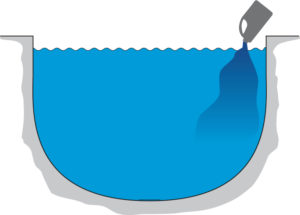
Carbon dioxide (CO2) is a common, essential compound in nature. It is found almost everywhere, from what flowers and trees breathe in, to what humans and animals breathe out; and to the bubbles in the soda you drink. In its warmer phase it is a gas, and in its colder phase it becomes a solid – dry ice. Our atmosphere (the air we breathe) contains a relatively small amount of gaseous carbon dioxide – only about 0.03% to 0.06% – which is fortunate, since levels around 10% or higher would cause us all to lose consciousness! Because it exists in the air, a slight amount of carbon dioxide can be absorbed by water.
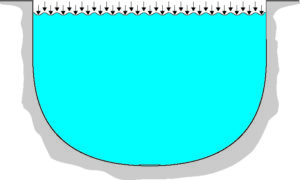
When dissolved in water, CO2 primarily exists as aqueous CO2, but a very small amount also combines with water to form carbonic acid: CO2 + H2O = H2CO3, and the slightly acidic nature of this compound lowers the pH.
The more CO2 in the water, the lower the pH. The less CO2, the higher the pH. Pool water with no dissolved CO2 (and alkalinity of 80 ppm) will seek a pH level of about 8.4.
As we all know, when acid is added, both the alkalinity and the pH are lowered. The alkalinity is lowered because the added acid reacts with bicarbonate and carbonate alkalinity in the water, converting it to CO2 and carbonic acid – which is then no longer alkalinity.
After adding acid to pool water, the pH goes down (at first) because of the effect on pH of the increasing amount of CO2 (aq) produced by adding the acid. Afterwards, the pH begins to rebound and eventually can return to its original level. This is due to the equilibrium relationship between the amount of CO2 in the water and the amount of CO2 in the air above the water. This is known as Henry’s Law.
Since the acid addition forms more CO2 (aq) in the water than is dictated by the equilibrium, most of the CO2 (aq) created by the addition of acid will then begin to release and off-gas into the atmosphere – which will gradually raise the pH level but not the alkalinity. The alkalinity remains the same.
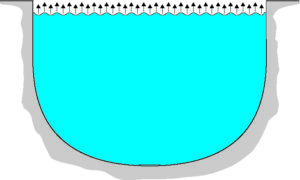
The “natural” level of CO2 in balanced pool water after it has had sufficient time to reach equilibrium with the atmosphere is from about 0.5 ppm to 2.0 ppm and the pH will be around 8.0 to 8.5 depending on the amount of carbonate alkalinity.
Since CO2 in water helps keep calcium soluble in water, pool water should be maintained with just enough CO2 to keep the pH down in the mid to high 7 range. Too much CO2 in water creates low pH conditions that are aggressive to pool plaster, and no CO2 may create high pH conditions that can be scale forming to all pool surfaces. Of course, etching and scaling are something service techs are always trying to prevent from happening.
In balanced swimming pool water, why does the pH begin to rise after acid lowers it? One answer lies in the fact that whenever the pH is below 8.2, there is generally more CO2 in water than its natural equilibrium level with the atmosphere. Because of this, the extra CO2 will off-gas into the atmosphere over time, and the pH rises.
Unless checked, the pH will continue to rise until the CO2 reaches its equilibrium of about 8.2 to 8.6 depending on the amount of carbonate alkalinity. The lower the starting pH, the faster it rises at first. The more alkalinity (80 ppm and higher), the stronger pull to a pH of 8.2 and higher. This is one of the difficulties that pool service techs have to deal with.
But there are exceptions to the above rule. For instance, a common but occasionally unrecognized factor which interferes with CO2 off-gassing or absorption is a pool cover. When pools are covered with non-gas permeable covers, such as the common blue bubble solar blankets or solid vinyl automatic safety covers, the exchange of gas from water to air and air to water is blocked. The pH can remain unchanged for many days, even weeks, when pool covers remain on the pool.
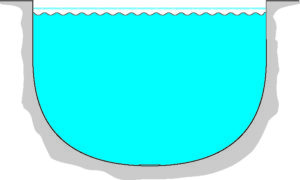
So how long does it take for CO2 to off-gas after adding acid for typical pool water? Or, why does the pH “rebound” happen faster and higher in some pools than others, or faster one time than another in the same pool?
CO2 off gassing, and its relative speed, are dependent on several factors, which includes alkalinity, the starting pH, water temperature, circulation, ratio of water volume to air-exposed surface, and atmospheric pressure.
Factors which accelerate off-gassing (and speed of pH rebound) include higher carbonate alkalinity (above 80 ppm), lower starting pH, higher water temperatures, increased circulation, higher air-exposed surface area to water volume, and especially increased aeration as seen with jets, waterfalls, fountains, and spas.
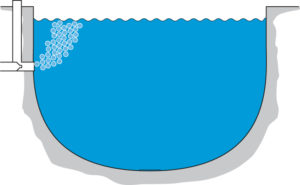
Factors which inhibit off-gassing (thus slowing down pH rebound) include lower carbonate alkalinity, higher starting pH, decreased aeration, decreased circulation, lower air-exposed surface area to water volume, and lower water temperature.
Service techs can observe for themselves the speed at which CO2 off-gasses by watching the speed at which the pH increases. They can detect how some pools have a major change in the pH within a day or two, maybe even in just a few hours, while some pools take over a week to have a significant change in the pH.
